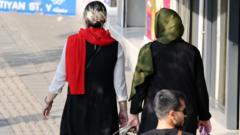The UN's recent report reveals that Iranian authorities are deploying advanced surveillance techniques, including drones and facial recognition technology, to monitor compliance with the mandatory hijab laws. The government's strategy aims to create a culture of "state-sponsored vigilantism," encouraging citizens to report violations via specialized apps.
### Iran Intensifies Control Over Women's Dress Code Using Drones and Technology

### Iran Intensifies Control Over Women's Dress Code Using Drones and Technology
Iran's government is leveraging drones and apps to enforce strict dress codes, particularly targeting women, as reported by the United Nations.
In Iran, non-compliance with the hijab law can result in severe repercussions, including imprisonment and violent treatment. The report underscores systematic discrimination against women, ongoing threats, and the chilling impact of surveillance, culminating from the aftermath of the protests ignited by the tragic death of Mahsa Amini in 2022.
The use of apps like "Nazer" enables users to report women who violate the dress code, allowing the government to punish not just the women but also vehicle owners through fines and confiscation. This level of state surveillance showcases the lengths to which Iran will go to maintain strict control over women's rights. With the report set for presentation to the Human Rights Council, the plight of Iranian women continues to draw international attention and condemnation.
The harsh realities of life for women in Iran, coupled with ongoing protests, highlight the urgent need for global awareness and action regarding human rights violations in the country.
The use of apps like "Nazer" enables users to report women who violate the dress code, allowing the government to punish not just the women but also vehicle owners through fines and confiscation. This level of state surveillance showcases the lengths to which Iran will go to maintain strict control over women's rights. With the report set for presentation to the Human Rights Council, the plight of Iranian women continues to draw international attention and condemnation.
The harsh realities of life for women in Iran, coupled with ongoing protests, highlight the urgent need for global awareness and action regarding human rights violations in the country.























